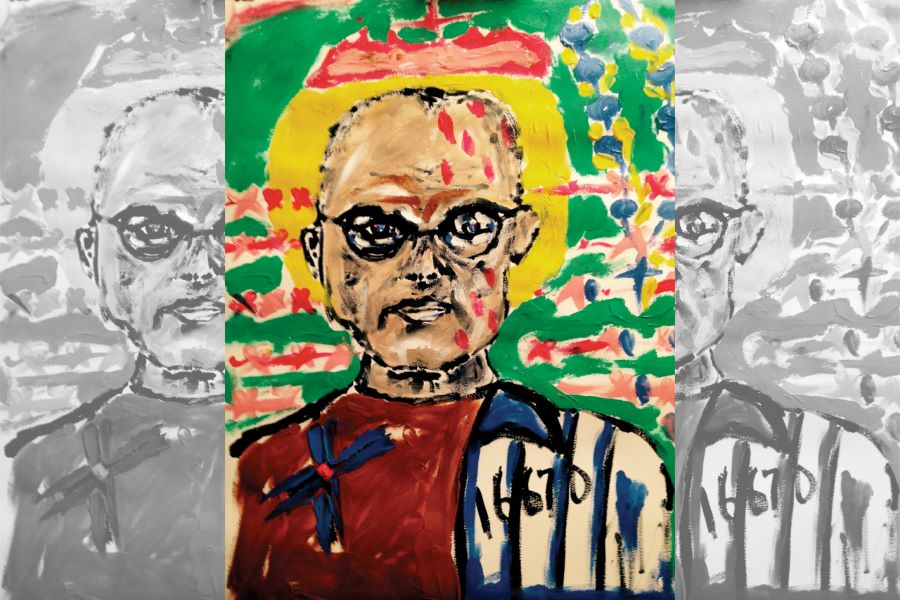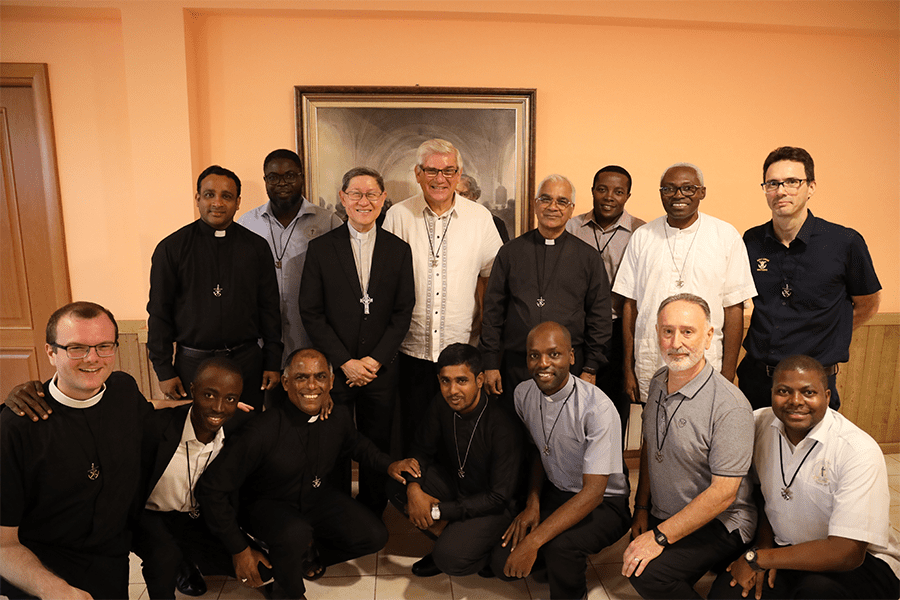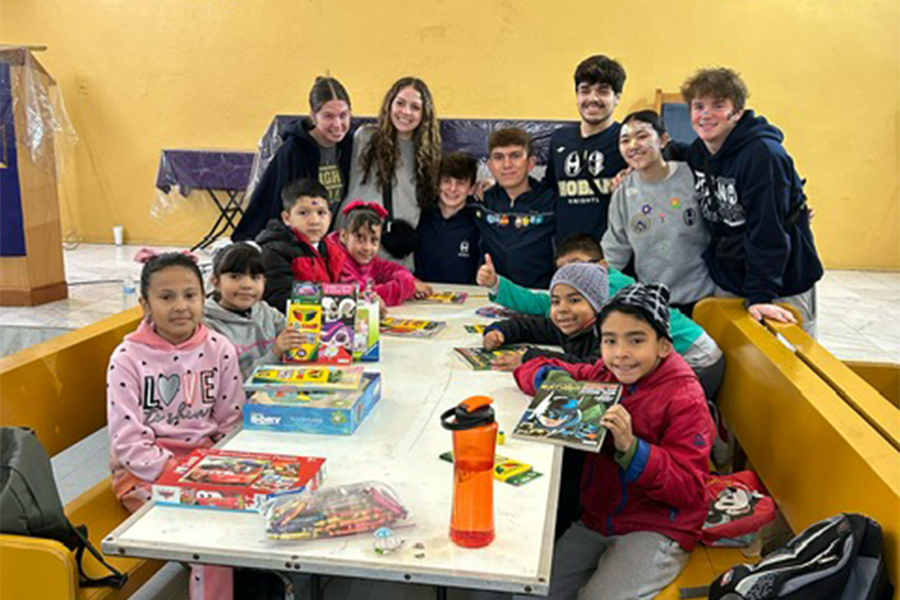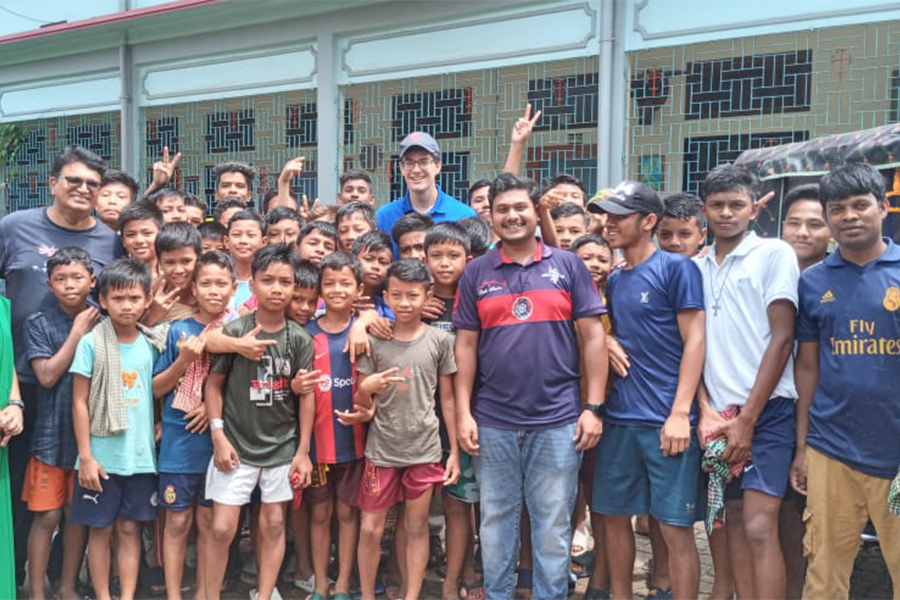Maximilian Kolbe, OFM Conv, born Raymund Kolbe, was a Roman Catholic priest and a conventual Franciscan friar. He was martyred in the German death camp of Auschwitz on August 14, 1941, dying from a lethal injection of carbolic acid in a starvation cell after he volunteered to take the place of a man who was in line to be murdered. He was canonized on October 10, 1982. His life, his decision to help another man live, is a profound light from one of the darkest periods in our world’s history. His faith is a story to be told over and over, to be interpreted for generations. I felt guided by him in many ways as I prepared for my own priesthood in 1983.
I painted this image of Saint Maximillian Kolbe in 2015. I used acrylic paint on my fingers, trying to touch this man’s courage and selflessness, wanting to glimpse how his faith flourished as he encountered such human anguish. Even though the image is not uniquely my own, I asked Jesus to show me, through my own hands, Kolbe’s encounter with divine love. There is no one way to fully portray or understand the deep and passionate faith Kolbe possessed as he faced torture and still offered his life to save a married man with children; I could capture only a hint of how he survived such horrific treatment. This image remains incomplete, simple, childlike, and naïve.
In recent years, finger painting has become, for me, an act of faith and intuition. Praying through art teaches me about the lives of the saints and the mystery of their dedication to Christ Jesus. The following comments tell of what I found in creating this simple painting.
Crown: Mary, the Mother of God, offered Kolbe two crowns in a vision when he was twelve years old. His innocence affirmed the gift of a white crown representing sainthood and a red crown representing martyrdom. In the vision, he accepted both crowns from the Mother of God. Kolbe held this vision in his heart his entire life, and it formed his deep faith and his willingness to offer his life to the priesthood. The crown was placed upon his heart and he never let go of the vision that his life was for a greater cause — to ultimately glorify God.
Mary, the Mother of God: Mary’s appearance to the young Maximillian gave his life purpose and meaning while he was growing up in Poland. His heart was united to God through Mary. The rosary spoke to him as a constant reminder of the vision Mary had offered him. The fidelity of faith was manifested in beads. Notice in the painting that beads stream from the crown on Kolbe’s head. The blue beads flow into the barbed wire; the spikes in the wire become the beads of prayer. My central insight is that to survive the horror, Fr. Kolbe prayed the rosary in his heart by counting the barbs on the wire that confined him. I believe that the painful pieces of wire that held the prisoners in the concentration camp became a rhythm of prayer for him. The wire knots became a source of intimacy, a way into his inner love of God. Pain and confinement were transformed into faith and freedom. Kolbe explored the Mysteries of the Rosary through the wire knots that hindered hundreds of people from escaping. That which hurt him and others led to his surrender to God and his eventual acceptance of the crown of martyrdom. This realization upon my fingers, touching the barbs in my mind and transforming them into prayer, has led me deeper into the mystery of Christ’s passion, death, and resurrection.
The brown shirt: The shirt portrays his brown Franciscan habit, with a red mark on the cross to represent the martyr of the martyrs, Jesus Christ. Fr. Kolbe was clothed in simplicity for his entire life as a religious and priest. The simple habit of a friar prepared him to wear the striped shirt of a prisoner. Both the brown shirt and the prisoner’s uniform are transformed in his death; in his life as a saint, he now is clothed in God’s eternal glory.
The prisoner uniform: The number 16670 on Fr. Kolbe’s uniform defined him as a prisoner, yet he knew his true identity in God’s love. The uniform clothed his body, but God’s fidelity toward him covered his soul. For Kolbe, there was no mark or number from any earthly prison that could erase God’s presence and love in him.
The drops of blood on his face: Kolbe was beaten and brutalized while imprisoned, but even in those horrific conditions people recognized his faith. The droplets of blood in the painting represent the ten individuals who died by lethal injection on that August day in 1941. The blood comes from Fr. Kolbe’s red crown, flowing over his face, so that we may remember the tragedies of the concentration camps. The people who died with him are known and recognized now in the eternal face of Christ Jesus.
The green background: The green background represents hope both for the people who died and the people who survived such anguish and suffering. The green backdrop invites us all into our own suffering and the realization that Christ will lead us to green pastures where forgiveness, mercy, and tenderness welcome us. The mysteries of Christ’s passion, death, and resurrection led Maximilian to green pastures of safety and mercy in heaven.
The gold halo: After weeks in a starvation bunker, Kolbe was one of three people still living. Witnesses recalled him being at peace, praying for those who held him and others captive, praying for the end of war and violence. There is a light within us when we surrender to God, a light that will give us direction and courage and will lead us all home to the face of Jesus Christ.
Acrylic paint on my fingertips helped me understand Fr. Kolbe’s ability to surrender his pain and the pain of others to God. True freedom is not outside of our own lives but comes only from within when we finally surrender our pain to Christ. Kolbe’s life and death speak boldly to me, as the artist. I ask for the grace to transform human suffering into hope, courage, and love.
Remarkably, Franciszek Gajowniczek, the man Fr. Kolbe saved, survived the war and attended both the beatification and canonization ceremonies years later. He lived to be 91 years old.
Prayer:
Mary, Mother of God, pray for us.
Lord Jesus Christ, save your people.
______________________________________________________________________________________________________________________________________________________________________________________________________________
About:
Rev. Ronald Patrick Raab, CSC serves as religious superior of Holy Cross House, our retirement and medical facility at Notre Dame, Indiana. He is an award-winning author, blogger, and visual artist. Learn more at ronaldraab.com
Artwork:
Fr. Ron finger-painted this image of Saint Maximilian Kolbe in 2015, and has used this image for his own prayer for many years. Fr. Ron’s art has been published in dioceses and parishes throughout the world.
Published June 26, 2024




